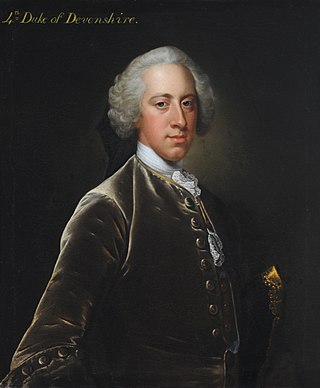
John Stuart, 3rd Earl of Bute,, styled Lord Mount Stuart between 1713 and 1723, was a British nobleman who served as the Prime Minister of Great Britain from 1762 to 1763 under George III. He became the first Tory to hold the position and was arguably the last important royal favourite in British politics. He was the first prime minister from Scotland following the Acts of Union in 1707. He was also elected as the first president of the Society of Antiquaries of Scotland when it was founded in 1780.

William Cavendish, 4th Duke of Devonshire,, styled Lord Cavendish before 1729, and Marquess of Hartington between 1729 and 1755, was a British Whig statesman and nobleman who was briefly nominal Prime Minister of Great Britain. He was the first son of William Cavendish, 3rd Duke of Devonshire and his wife, Catherine Hoskins. He is also a great-great-great-great-great-grandfather of King Charles III through the king's maternal great-grandmother.

Evelyn Pierrepont, 1st Duke of Kingston-upon-Hull, was an English aristocrat.

Lady Mary Wortley Montagu was an English aristocrat, medical pioneer, writer, and poet. Born in 1689, Lady Mary spent her early life in England. In 1712, Lady Mary married Edward Wortley Montagu, who later served as the British ambassador to the Sublime Porte. Lady Mary joined her husband on the Ottoman excursion, where she was to spend the next two years of her life. During her time there, Lady Mary wrote extensively on her experience as a woman in Ottoman Constantinople. After her return to England, Lady Mary devoted her attention to the upbringing of her family before dying of cancer in 1762.

Colonel James Archibald Stuart-Wortley-Mackenzie, 1st Baron Wharncliffe, PC was a British soldier and politician. A grandson of Prime Minister John Stuart, 3rd Earl of Bute, he held office under Sir Robert Peel as Lord Privy Seal between 1834 and 1835 and as Lord President of the Council between 1841 and 1845.

Marquess of the County of Bute, shortened in general usage to Marquess of Bute, is a title in the Peerage of Great Britain. It was created in 1796 for John Stuart, 4th Earl of Bute.

Earl of Wharncliffe, in the West Riding of the County of York, is a title in the Peerage of the United Kingdom.

Granville Leveson-Gower, 1st Marquess of Stafford, KG PC, known as Viscount Trentham from 1746 to 1754 and as The Earl Gower from 1754 to 1786, was a British politician from the Leveson-Gower family. Sitting in the House of Lords, he spent a quarter of a century in the Cabinet.

Lieutenant-General Sir Charles Stuart was a British Army officer and politiciain. The fourth son of John Stuart, 3rd Earl of Bute and Mary Wortley Montagu, he was born in Kenwood House, London. There is a famous painting in the Tate Gallery, London, of him aged 10 stealing eggs and chicks from a bird's nest.

Dorothy Montagu, Countess of Sandwich, formerly The Hon. Dorothy Fane, was a British peeress and wife of the 4th Earl of Sandwich.

Charles (Medows) Pierrepont, 1st Earl Manvers was a British naval officer and politician who sat in the House of Commons from 1778 to 1796 when he was raised to the peerage as Viscount Newark.

Edward Wortley Montagu was an English coal-owner and politician. He was British Ambassador to the Ottoman Empire, husband of the writer Lady Mary Wortley Montagu and father of the writer and traveller Edward Wortley Montagu.

Lady Louisa Stuart was a British writer of the 18th and 19th centuries. Her long life spanned nearly ninety-four years.
James Stuart-Mackenzie PC FRSE FSA was a Scottish politician and joint founder of the Royal Society of Edinburgh in 1783. The second son of James Stuart, 2nd Earl of Bute, he served as Member of Parliament for various Scottish constituencies of the Parliament of Great Britain from 1742 to 1780. Stuart-Mackenzie was the British Minister at Turin from 1758 to 1761. He was made a Privy Councillor in 1761, and served as Keeper of the Privy Seal of Scotland from 1763 to 1765, and again from the following year until his death in 1800.

John Stuart-Wortley, 2nd Baron Wharncliffe FRS, was a British Tory politician. He served briefly as Under-Secretary of State for War and the Colonies between December 1834 and January 1835.

Frederick Stuart was a British East India Company employee and politician.
Mary Montagu may refer to:
Sir Philip Meadowes or Meadows (1672–1757) was an English politician and diplomat.
John Dawson, 1st Earl of Portarlington PC (Ire) was an Anglo-Irish politician and peer.
















